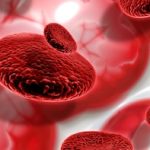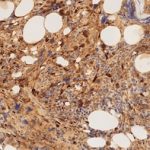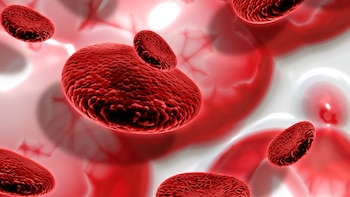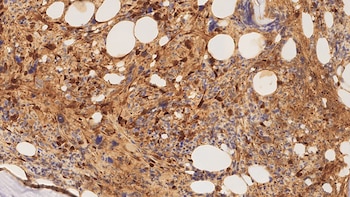









Two people per 100,000 inhabitants develop a disease each year. bone marrow diseasewhich causes too many blood cells of a specific type, such as red blood cells, platelets, or white blood cells. In some cases, the disorders, which are known as myeloproliferative neoplasmscan progress to more serious forms such as leukemia.
Scientists of the Conicet and the Faculty of Exact and Natural Sciences of the University of Buenos Aires of Argentina and the Oxford Universityin the United Kingdom, managed to identify that a protein may be useful as a biomarker to help diagnose myeloproliferative neoplasms.
The protein is called galectin-1 and previous studies have shown that It has a determining role in many processes related to the functioning of the immune system. of the human body.
The new research went further: the scientists also managed to show that a antibody monoclonal could become a potential intervention for the treatment of those pathologies.

The research was published in the journal Science Translational Medicinefrom the magazine group American Association for the Advancement of Sciences. The results still need to be verified through clinical trials with human volunteers that evaluate efficacy and safety.
In dialogue with Infobaethe doctor Gabriel Rabinovichone of the co-authors from the Argentine side – who works at the Institute of Biology and Experimental Medicine (IBYME) from Conicet- told the details of the study.
“Several years ago, the group of researchers from Bethan Psaila and Adam Meadat the University of Oxford, contacted us to carry out a collaboration. They had studied and published on myeloproliferative neoplasms, such as myelofibrosis. It is known that there are three mutations that can be acquired during human life that are involved,” he said.
The scientists in the United Kingdom They were studying the genes and cells of patients with the disease compared to healthy people. There they found that patients with myelofibrosis had higher levels of the protein galectin-1.

Therefore, they contacted the group of Rabinovichwhich has been unraveling different roles of that protein since 1994 and is developing therapeutic strategies for different cancers and autoimmune diseases.
Together, researchers from Argentina and the United Kingdom mapped the cross-talk between cell types in the bone marrow with myelofibrosis.
They observed that the inflammation and fibrosis produced by the condition are orchestrated by a “quartet” of different cell lineages and clarified how a signaling center is created that allows their interaction.

In this context, they identified that the galectin-1 protein may serve as a biomarker of progression to myelofibrosis in patients. Next, they tested the monoclonal antibody that Rabinovich and his team have been evaluating in preclinical trials.
In laboratory tests, with mice on the one hand and with human bone marrow organoids, they demonstrated that the use of the antibody can reduce the fibrosis caused by the disease. It does this by inhibiting the action of galectin-1.

“Before this study, we already knew that the antibody can block blood vessels that encourage tumors to proliferate, among other effects. Now, after five years of research, We found that the antibody manages to reverse fibrosis in blood disorders. That is, the antibody has an antifibrotic effect depending on the system in mice and in organoids,” Rabinovich explained.
As part of the new research, he also collaborated Juan Manuel Pérez SáezConicet scientist, co-founder of biocompany Galtec together with Rabinovich, and one of those responsible for the development of the monoclonal antibody.

In a statement, Dr. Psailahighlighted: “This discovery not only helps us better understand how myeloproliferative neoplasms progress, but also provides us with a new tool to predict and possibly prevent this progression.”
Psaila emphasized that the development of therapies targeting galectin-1 could change treatment and significantly improve patients’ quality of life.
“Our goal is to translate these findings to the clinical setting as soon as possible to benefit patients,” explained Dr. Mead.
In patients, the disease myelofibrosis causes extensive scarring or fibrosis of the bone marrow and prevents the production of blood elements. This leads to an increase in the size of the spleen, and the development of various symptoms.

The most common may include a persistent feeling of fatigue and weakness. Many also experience pain or a feeling of fullness in the abdomen, which is caused by an enlarged spleen.
In addition, fever, night sweats, and unexplained weight loss are common. Other symptoms may include easy bruising or bleeding, as well as bone or joint pain.
“Currently, there is a lack of tools to control the blood counts and avoid transfusions. “The available treatments can control symptoms and reduce the size of the spleen, but they do not prevent the progression of fibrosis in a sustained manner,” he told Infobae the doctor Ana Ines Varelaspecialist in hematology and clinical researcher at Ramos Mejía Hospital from Buenos Aires and member of the Argentine Society of Hematology.

“The results of the work published in the journal Science Translational Medicine They open a path to further research into myelofibrosis,” he stated.
This is preclinical research “but it undoubtedly provides a lot of hope,” said Varela. Hopefully we can offer patients a safe option that can slow the disease and reverse fibrosis in the future.”

Meanwhile, the doctor Guillermo Arbesuspecialist in hematology and member of the Argentine Group for the treatment of malignant hemopathies (GATLA)he said when asked by Infobae: “The identification of Galectin-1 as a therapeutic target brings new hope for treating a rare and serious disease that has seen little progress in recent years.”
The ongoing development of a monoclonal antibody against galectin-1 shows – added the specialist – “how basic scientific discoveries They can be transformed into more effective treatments. This comprehensive approach It is key to facing complex diseases and promote the advancement of translational medicine, and the importance of Argentine research at a global level is also highlighted.”
